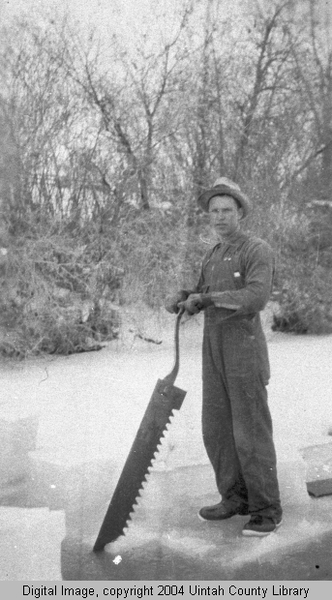Dublin Core
Title
Description
During the nineteenth-century, frozen water was a rare and valuable commodity. Year-round access to ice was an important business operation for railroad companies, and for many Utahns was also a family operation. Ice harvested during winter could be carefully stored for consumption during summer months.
The shore of Utah Lake was home to two icehouses that were owned and operated by the railroad. The changing food industry meant that meat and other perishables transported by rail across the country required refrigeration. Throughout the 1880s, workers harvested the thick ice from Utah Lake each winter to preserve the railroad's food cargo year-round.
Icehouses were also important for Utah households, and families worked together throughout the winter to harvest slabs of ice for storage. To extract ice from a pond, men used hand saws to cut large blocks from the frozen surface. Pulling the ice on sleds to the family icehouse, they would blanket the blocks in thick layers of sawdust to insulate them from warming temperatures. During especially cold winters, a harvest could supply a family with enough ice to last the entire summer.
The reward for this back-breaking work was a fully-stocked icebox that could preserve food through summer heat waves, and maybe enough ice to cool down a homemade root beer or to churn a batch of ice cream. Beyond food preservation, and relief from Utah’s hot summers, local morticians also required access to icehouses. Prior to the rise of embalming services, morticians would pack the corpses in ice to keep them looking fresh for funerals.
Harvesting ice was cold, difficult, and time-consuming work. Before household and industrial freezers, it was ~ice~ that ensured the safe storage and shipment of perishables and kept Utahns cool during the hot summer months. So think about ~that~ the next time you stand in front of the fridge with the door wide open!
Creator
Source
_______________
See: Beth R. Olsen, “Winter Fun in Northern Utah Valley,” Utah Historical Quarterly 69 (2001): 327; Katie D. Maylett, “The Candy Man” Saga of the Sanpitch 8 (1976): 60; Richard C. Roberts and Richard W. Sadler, A History of Weber County (Salt Lake City: Utah State Historical Society and Weber County, 1997): 127.

